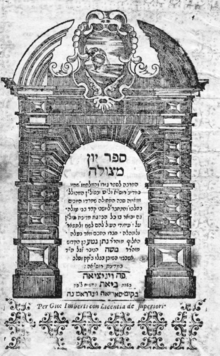Yeven Mezulah (original) (raw)
From Wikipedia, the free encyclopedia
17th-century book by Nathan ben Moses Hannover
Title page says: "Book Depth of Mire", original 1653 edition
Yeven Mezulah (Hebrew: יוון מצולה) is a 17th-century book by Nathan ben Moses Hannover, translated into English as Abyss of Despair in 1950.[1] It describes the course of the Khmelnytsky Uprising in the Polish–Lithuanian Commonwealth from a Jewish perspective. Hannover in this work gives a brief description of the Polish Crown of the time and of the relations between the Poles, Jews and Cossacks, and the causes which led to the uprising. He also gives a vivid picture of Jewish life in Poland and the yeshivot.
The book was printed in Hebrew in Venice in 1653. It was translated into Yiddish (1687), into German (1720), and into French by Daniel Levy (published by Benjamin II, Tlemçen, 1855). This last translation was revised by the historian J. Lelewel, and served as a basis for Meyer Kayserling's German translation (also published by Benjamin II, Hanover, 1863). Kostomarov, utilizing Salomon Mandelkern's Russian translation, gives many extracts from it in his Bogdan Chmielnicki (iii. 283–306).[_citation needed_]
Sources and credibility
[edit]
First edition of Yeven Mezulah (1653): "I write of the Evil Decrees of Chmiel, may his name be obliterated... in (5)'408 to '411 Anno Mundi"
Rabbi Hannover witnessed the outbreak of the events in Zasław, from which he fled to Międzybóż. In addition, he compiled the rest of the book from rumors and other printed sources: "Tzok ha-Ittim" [Sufferings of the Times] by Meir ben Samuel of Shcherbreshin (published in 1650), "Meghillat Efa" [Scroll of Darkness] by Shabbatai HaKohen (1651), and "Petach Teshuva" (פתח תשובה, "Gates of Penitence") by Gabriel Ben Yehoshua Schussburg (1651).[_citation needed_]
In the late 20th century some historians disputed the numbers given Yeven Mezulah. They claim it overstates Jewish casualties during the Bohdan Khmelnytsky rebellion in 1648 and 1649. These authors tend to question it as a reliable historical source in spite of its literary qualities. Yeven Mezulah was criticized in particular by Shaul Stampfer, Edward Fram, Paul Robert Magocsi's "Ukraine: A History", and Petro Mirchuk.[2][3][4]However other authors regard it as a reliable historical account.[5][6]
The author writes in his introduction "I named my book YEVEN M'TZULAH (THE DEEP MIRE) because the words of Psalmist allude to these terrible events." (Earlier he is speaking of Psalm 69).[7] Before that, in the introduction the author performs some gematria: "TAVATI B'YAVAN M'FZULAH (I am sunk in a deep mire) is of the same numerical value as "CHMIEL VKEDAR B'YAVAN YACHDAV CHUBARU (Chmiel[nitski] and the Tartars joined together with the "Greeks"), which involves a biblical pun: hinting that he sunk into the mire of Yevanim (the word is derived from "Ionians" i.e., "Greeks", which is a metonymic hint to the Eastern (Greek) Orthodox Church, i.e., Cossacks/Russians.[8] Jakob Josef Petuchowski suggests that this pun / allusion ("mire"/"Greeks"/"Russians") was known to the censors of the Russian Empire and therefore Yeven Mezulah was banned.[9]
Modern translations
[edit]
- 1912: Polish by Majer Balaban as Jawein mecula, t.j. Bagno głębokie. Kronika zdarzeń z lat 1648–1652 napisana przez Natana Hannowera z Zasławia i wydana po raz pierwszy w Wenecyi w r. 1653
- 1950: English by Abraham Mesch as Abyss of Despair (Yeven Metzulah): The Famous 17th Century Chronicle Depicting Jewish Life in Russia and Poland During the Chmielnicki Massacres of 1648–1649
- 1997: Russian by Saul Borovoi [ru] as Пучина бездонная: Еврейские хроники XVII столетия
- 2010: Ukrainian by Natalya Yakovenko as Глибокий мул. Хроніка Натана Гановера (ISBN 978-966-378-154-9)
- ^ "Hannover, Natan Note", YIVO Encclopedia
- ^ Stampfer, Shaul. "What Actually Happened to the Jews of Ukraine in 1648?" Jewish History 17, no. 2 (2003): 207–27.
- ^ Fram, Edward. "Creating a Tale of Martyrdom in Tulczyn, 1648." Jewish History and Jewish Memory, 1998.
- ^ Mirchuk, Petro. "My Meetings and Discussions in Israel: Ukrainian-Jewish Relations throughout the Ages." Accessed March 21, 2014. http://exlibris.org.ua/mirchuk/r08.html.
- ^ A. Gliwa. "The Tatar-Cossack Invasion of 1648: Military Actions, Material Destruction and Demographic Losses in the Land of Przemyśl". Acta Poloniae Historica 2012. Retrieved 2019-01-01.
- ^ Solomon Schechter. "HANNOVER, NATHAN (NATA) BEN MOSES". Jewish Encyclopedia. Retrieved 2019-06-09.
- ^ Abyss of Despair, Routledge, 2018, ISBN 1351534157, a fascimile of the original 1950 translation. p. 24
- ^ David G. Roskies, Against the Apocalypse: Responses to Catastrophe in Modern Jewish Culture, 1999, ISBN 081560615X p.49
- ^ Petuchowski, J.J.P.E.P.A.M. (1998). Studies in Modern Theology and Prayer. Jewish Publication Society. p. 200. ISBN 9780827610606. Retrieved 2022-03-13.
- Book text in the original Hebrew at Daat [he] website
- Book text in the 1950 English translation (Abyss of Despair)
- Book image at HebrewBooks.org (free download)

